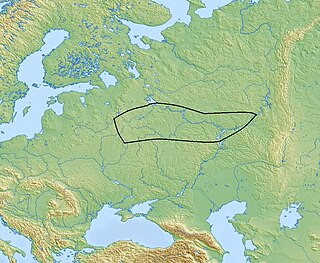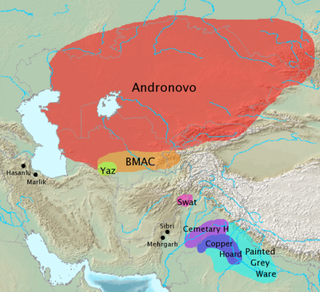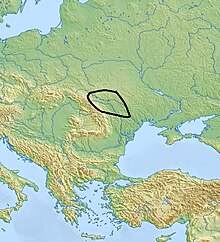The Komarov culture was a Bronze Age culture which flourished along the middle Dniester from 1500 BC to 1200 BC.
Few settlements from the Komarov culture have been found. One settlement at Komarov, from which the culture is named, contained twenty small single-roomed houses.
The Komarov culture is best known for its inhumation burials. These are set into a stone- or timber-covered grave covered with a tumulus. Cremations and flat grave burials are also known. Decorations found on ceramics, and the presence of stone rings and cromlechs around the base of the tumuli, indicate that a sun cult existed among the Komarov people.
The Komarov culture is believed to have originated within the Corded Ware horizon, with which is shares numerous similarities, including burial rites, ceramics and metallurgical traditions. It is closely related to the Trzciniec culture. The Komarov culture is usually associated with the evolution of the Proto-Slavs or the Thracians.

Kerameikos also known by its Latinized form Ceramicus, is an area of Athens, Greece, located to the northwest of the Acropolis, which includes an extensive area both within and outside the ancient city walls, on both sides of the Dipylon Gate and by the banks of the Eridanos River. It was the potters' quarter of the city, from which the English word "ceramic" is derived, and was also the site of an important cemetery and numerous funerary sculptures erected along the Sacred Way, a road from Athens to Eleusis.

A kurgan is a type of tumulus constructed over a grave, often characterized by containing a single human body along with grave vessels, weapons and horses. Originally in use on the Pontic–Caspian steppe, kurgans spread into much of Central Asia and Eastern, Southeast, Western and Northern Europe during the 3rd millennium BC.

A megalith is a large stone that has been used to construct a prehistoric structure or monument, either alone or together with other stones. There are over 35,000 in Europe alone, located widely from Sweden to the Mediterranean sea.

A gallery grave is a form of megalithic tomb built primarily during the Neolithic Age in Europe in which the main gallery of the tomb is entered without first passing through an antechamber or hallway. There are at least four major types of gallery grave, and they may be covered with an earthen mound or rock mound.

The Globular Amphora culture (GAC, German: Kugelamphoren-Kultur ; c. 3400–2800 BC, is an archaeological culture in Central Europe. Marija Gimbutas assumed an Indo-European origin, though this is contradicted by newer genetic studies that show a connection to the earlier wave of Early European Farmers rather than to Western Steppe Herders from the Ukrainian and western-southern Russian steppes.

The Catacomb culture was a Bronze Age culture which flourished on the Pontic steppe in 2500–1950 BC.

Poltavka culture was an early to middle Bronze Age archaeological culture which flourished on the Volga-Ural steppe and the forest steppe in 2800—2200 BCE.

The Fatyanovo–Balanovo culture was a Chalcolithic and early Bronze Age culture within the wider Corded Ware complex which flourished in the forests of Russia from c. 2900 to 2050 BC.

Sintashta is an archaeological site in Chelyabinsk Oblast, Russia. It is the remains of a fortified settlement dating to the Bronze Age, c. 2800–1600 BC, and is the type site of the Sintashta culture. The site has been characterised "fortified metallurgical industrial center".
The Ottomány culture, also known as Otomani culture in Romania or Otomani-Füzesabony culture in Hungary, was an early Bronze Age culture in Central Europe named after the eponymous site near the village of Ottomány, today part of Sălacea, located in modern-day Bihor County, Romania. The Middle Bronze Age period of the Ottomány culture in eastern Hungary and western Romania is also known as the Gyulavarsánd culture.

Shahr-e Sukhteh, c. 3550–2300 BC, also spelled as Shahr-e Sūkhté and Shahr-i Sōkhta, is an archaeological site of a sizable Bronze Age urban settlement, associated with the Helmand culture. It is located in Sistan and Baluchistan Province, the southeastern part of Iran, on the bank of the Helmand River, near the Zahedan-Zabol road. It was placed on the UNESCO World Heritage List in June 2014.

Within the boundaries of today's Bosnia and Herzegovina, there have been many layers of prehistoric cultures whose creation and disappearance are linked to migrations of unidentified ethnic groups.

The Golasecca culture was a Late Bronze Age/Early Iron Age culture in northern Italy, whose type-site was excavated at Golasecca in the province of Varese, Lombardy, where, in the area of Monsorino at the beginning of the 19th century, Abbot Giovanni Battista Giani made the first findings of about fifty graves with pottery and metal objects.

The Yaz culture was an early Iron Age culture of Margiana, Bactria and Sogdia. It emerges at the top of late Bronze Age sites (BMAC), sometimes as stone towers and sizeable houses associated with irrigation systems. Ceramics were mostly hand-made, but there was increasing use of wheel-thrown ware. There have been found bronze or iron arrowheads, also iron sickles or carpet knives among other artifacts.

Ancient Estonia refers to a period covering History of Estonia from the middle of the 8th millennium BC until the conquest and subjugation of the local Finnic tribes in the first quarter of the 13th century during the Teutonic and Danish Northern Crusades.

The Bronze and Iron Age cultures in Poland are known mainly from archeological research. Early Bronze Age cultures in Poland began around 2400–2300 BCE, while the Iron Age commenced in approximately 750–700 BCE. The Iron Age archeological cultures no longer existed by the start of the Common Era. The subject of the ethnicity and linguistic affiliation of the groups living in Central Europe at that time is, given the absence of written records, speculative, and accordingly there is considerable disagreement. In Poland the Lusatian culture, spanning both the Bronze and Iron Ages, became particularly prominent. The most famous archeological finding from that period is the Biskupin fortified settlement (gord) on the lake from which it takes its name, representing the Lusatian culture of the early Iron Age.

Poland in antiquity was characterized by peoples from various archeological cultures living in and migrating through various parts of what is now Poland, from about 400 BC to 450–500 AD. These people are identified as Slavs, Celts, Germanic peoples, Balts, Thracians, Avars, and Scythians. Other groups, difficult to identify, were most likely also present, as the ethnic composition of archeological cultures is often poorly recognized. While lacking any written language to speak of, many of them developed a relatively advanced material culture and social organization, as evidenced by the archeological record; for example, richly furnished, "princely" dynastic graves.

After the glaciers of the Ice Age in the Early Stone Age withdrew from the area, which since about 1000 AD is called Pomerania, in what are now northern Germany and Poland, they left a tundra. First humans appeared, hunting reindeer in the summer. A climate change in 8000 BC allowed hunters and foragers of the Ertebølle-Ellerbek culture to continuously inhabit the area. These people became influenced by farmers of the Linear Pottery culture who settled in southern Pomerania. The hunters of the Ertebølle-Ellerbek culture became farmers of the Funnelbeaker culture in 3000 BC. The Havelland culture dominated in the Uckermark from 2500 to 2000 BC. In 2400 BC, the Corded Ware culture reached Pomerania and introduced the domestic horse. Both Linear Pottery and Corded Ware culture have been associated with Indo-Europeans. Except for Western Pomerania, the Funnelbeaker culture was replaced by the Globular Amphora culture a thousand years later.

The Illyrian Tombs of Selca e Poshtme are located near the town of Pogradec in Albania near the village of Selcë e Poshtme. On the right bank of the river Shkumbin at an elevation of 1040 m above sea level, lie the remains of the ancient city of Pelion and the accompanying necropolis. The Roman Via Egnatia led past it towards Thessaloniki. Though there are traces of human activity in Neolithic times, the settlement proper dates to the Iron Age through to the Illyrian urban period, and reached its height under settlement by the Illyrian tribe of Enchele in the later Iron Age and was also occupied in the Roman period as traces of a municipal building show. From the 4th to 1st centuries BC the city was the royal residence of Illyrian kings and therefore, also probably an important political and economic centre. In 1996, Albania included the Royal tombs of Selca e Poshtme in the UNESCO World heritage list of proposals.

The Vakhsh culture is a Bronze Age culture which took place around 2500-1650 BC, as shown by radiocarbon dates, and flourished along the lower Vakhsh River in southern Tajikistan, earlier thought to be from ca. 1700 BC to 1500 BC.


















